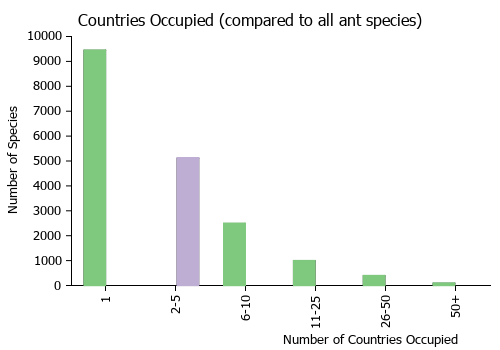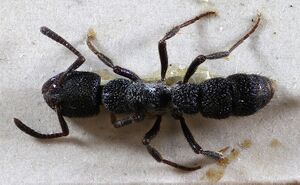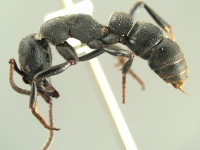Bothroponera cariosa
| Bothroponera cariosa | |
|---|---|

| |
| Scientific classification | |
| Kingdom: | Animalia |
| Phylum: | Arthropoda |
| Class: | Insecta |
| Order: | Hymenoptera |
| Family: | Formicidae |
| Subfamily: | Ponerinae |
| Tribe: | Ponerini |
| Genus: | Bothroponera |
| Species group: | pumicosa |
| Species: | B. cariosa |
| Binomial name | |
| Bothroponera cariosa Emery, 1895 | |
The sparse number of known records with collection details state the ants were found in rainforest and primary forest habitats. Little else is known about the biology of this species.
Identification
Joma and Mackay (2015) - A member of the Bothroponera pumicosa species complex. The total length of the worker B. cariosa is 10.15 - 11.50 mm. The head is subquadrate. The anterior medial border of the clypeus is “u” shaped with the medial longitudinal clypeal area raised to form a sharp carina. The mandibles are partially covered by weakly defined striae with scattered coarse punctures. The scape does not reach the posterior lateral border of the head.
Bothroponera cariosa is similar to many other species of the Bothroponera pumicosa species complex with a “u” shaped anterior medial margin of the clypeus (e.g. Bothroponera berthoudi, Bothroponera strigulosa, Bothroponera pumicosa, and Bothroponera laevissima), but the anterior medial area of the clypeus is developed into a sharp longitudinal carina, which is similar to that of B. strigulosa. The sharp carina is partially present in B. pumicosa while it is absent in B. berthoudi and B. laevissima.
Bothroponera granosa is the other species in the B. pumicosa species complex that has the clypeus raised to form a sharp carina, but the anterior medial margin of the clypeus is “v” shaped. The “v” shaped clypeus is also present in Bothroponera aspera and Bothroponera umgodikulula, but both B. aspera and B. umgodikulula lack the carina and the surface of the disc is smooth and rounded. This area is formed into partial carinae in Bothroponera montivaga and Bothroponera cavernosa. The petiole viewed from above is similar to that of B. berthoudi, but is definitely indented posteriorly in B. cariosa, but nearly straight and not indented in B. berthoudi. Bothroponera cariosa has total length about 11.50 mm, which is longer than that of B. berthoudi (9.60 – 12 mm) while it is smaller than that of B. cavernosa (12 mm), B. montivaga (12.20 - 12.65 mm), B. granosa (13.75 - 14.50 mm), B. strigulosa (12.20 mm), B. umgodikulula (14.80 - 15.65 mm), B. laevissima (12 - 13.00 mm), and B. aspera (12 – 13 mm). The total length of Bothroponera pumicosa ranges from 11.00 - 11.65, which overlaps the total length of B. cariosa.
Keys including this Species
Distribution
Latitudinal Distribution Pattern
Latitudinal Range: -8.23889° to -33.9289443°.
| North Temperate |
North Subtropical |
Tropical | South Subtropical |
South Temperate |
- Source: AntMaps
Distribution based on Regional Taxon Lists
Afrotropical Region: Mozambique (type locality), United Republic of Tanzania.
Distribution based on AntMaps
Distribution based on AntWeb specimens
Check data from AntWeb
Countries Occupied
| Number of countries occupied by this species based on AntWiki Regional Taxon Lists. In general, fewer countries occupied indicates a narrower range, while more countries indicates a more widespread species. |

|
Estimated Abundance
| Relative abundance based on number of AntMaps records per species (this species within the purple bar). Fewer records (to the left) indicates a less abundant/encountered species while more records (to the right) indicates more abundant/encountered species. |

|
Biology
Castes
Worker
   
| |
| . | Owned by Museum of Comparative Zoology. |
Nomenclature
The following information is derived from Barry Bolton's Online Catalogue of the Ants of the World.
- cariosa. Bothroponera cariosa Emery, 1895h: 20 (w.) MOZAMBIQUE.
- Type-material: holotype worker.
- Type-locality: Mozambique: Delagoa Bay (no collector’s name).
- Type-depository: MSNG.
- Wheeler, G.C. & Wheeler, J. 1971c: 389 (l.).
- Combination in Pachycondyla (Bothroponera): Emery, 1901a: 45;
- combination in Pachycondyla: Brown, in Bolton, 1995b: 303;
- combination in Bothroponera: Mayr, 1862: 717; Wheeler, W.M. 1922a: 72; Joma & Mackay, 2013: 3; Schmidt, C.A. & Shattuck, 2014: 76.
- Status as species: Emery, 1911d: 76; Arnold, 1915: 59; Wheeler, W.M. 1922a: 72 (in key); 769; Bolton, 1995b: 303; Joma & Mackay, 2015: 547 (redescription).
- Distribution: Gabon, Mozambique, South Africa, Tanzania.
Unless otherwise noted the text for the remainder of this section is reported from the publication that includes the original description.
Description
Worker
Joma and Mackay (2015) - (n=2 for measurements), HL 2.25 - 2.50, HW 1.95 - 2.15, ML 1.25 - 1.40, EW 0.30, EL 0.35 - 0.40, SL 1.45 - 1.60, FL 2.45 - 2.75, WL 2.90 - 3.35, WPL 3.80 - 4.40, PL 1.15 - 1.25, PW 1.20 - 1.45, PH 1.25 - 1.50, CI 86 - 87, OI 17.94 - 18.60, MandI 55.56 – 56.00, SI 74, PetI 104 – 116. Maximum clypeal width 1.90 mm; mandibles with 7 teeth, partially covered by weakly defined striae with scattered coarse punctures; maximum frontal lobe width 0.95 mm; length of malar space 0.40 - 0.60 mm, length from upper edge of eye to edge of posterior lobe 1.20 - 1.55 mm; compound eyes relatively large; head coarsely foveolate; lower margin of pronotum straight with rounded inferior and anteroinferior pronotal processes; basalar sclerite oval-shaped; antennae, legs, mandibles shiny; petiole thick, anterior face and apex rounded, seen from above slightly narrowed anteriorly with depression on upper medial margin between two edges posteriorly (seen from above), posterior face vertical (side view), slightly concave; sternopetiolar process developed with one tooth pointed ventrally; entire surface covered with fine scattered suberect to erect hairs, including mandibles, scapes; head covered with short (0.05 - 0.10 mm) erect golden hairs, pronotum, mesonotum, propodeum covered with short (0.05 - 0.15 mm) erect golden hairs, petiole, postpetiole, entire gaster covered with longer (0.15 - 0.25 mm) erect golden hairs; head, entire mesosoma (pronotum, mesonotum, mesopleuron, propodeum), petiole, postpetiole, entire gastral segments black; appendages (legs, antennae, mandibles) reddish brown; clypeus dark-brown; funiculus brown.
Type Material
Joma and Mackay (2015) - MOZAMBIQUE: Delagoa Bay, mountains, 25°59’0’’ S; 32°42’0’’ E, type, Bothroponera cariosa Emery, Holotypus Pachycondyla cariosa Emery 1895, Museo Geneva coll. C. Emery (1w holotype, Museo Civico di Storia Naturale, Genoa).
References
- Brown, W. L., Jr. 1995a. [Untitled. Taxonomic changes in Pachycondyla attributed to Brown.] Pp. 302-311 in: Bolton, B. A new general catalogue of the ants of the world. Cambridge, Mass.: Harvard University Press, 504 pp. (page 303, Combination in Pachycondyla)
- Emery, C. 1895i. Voyage de M. E. Simon dans l'Afrique australe (janvier-avril 1893). 3e mémoire. Formicides. Ann. Soc. Entomol. Fr. 64: 15-56 (page 20, worker described)
- Emery, C. 1901b. Notes sur les sous-familles des Dorylines et Ponérines (Famille des Formicides). Ann. Soc. Entomol. Belg. 45: 32-54 (page 45, Combination in Pachycondyla (Bothroponera))
- Esteves, F.A., Fisher, B.L. 2021. Corrieopone nouragues gen. nov., sp. nov., a new Ponerinae from French Guiana (Hymenoptera, Formicidae). ZooKeys 1074, 83–173 (doi:10.3897/zookeys.1074.75551).
- Joma, A.M.A. & Mackay, W.P. 2015. Revision of the African ants of the Bothroponera pumicosa species complex (Hymenoptera: Formicidae: Ponerinae). Sociobiology 62: 538-563 (doi:10.13102/sociobiology.v62i4.845).
- Joma, A.M.A., Mackay, W.P. 2020. Revision of the African ants of the Bothroponera talpa species complex (Hymenoptera: Formicidae: Ponerinae). Transactions of the American Entomological Society 146: 355-408. (doi:10.3157/061.146.0206).
- Schmidt, C.A. & Shattuck, S.O. 2014. The higher classification of the ant subfamily Ponerinae (Hymenoptera: Formicidae), with a review of ponerine ecology and behavior. Zootaxa 3817, 1–242 (doi:10.11646/zootaxa.3817.1.1).
- Wheeler, G. C.; Wheeler, J. 1971c. The larvae of the ant genus Bothroponera (Hymenoptera: Formicidae). Proc. Entomol. Soc. Wash. 73: 386-394 (page 389, larva described)
- Wheeler, W. M. 1922b. Ants of the American Museum Congo expedition. A contribution to the myrmecology of Africa. II. The ants collected by the American Museum Congo Expedition. Bull. Am. Mus. Nat. Hist. 45: 39-269 (page 72, Combination in Bothroponera)
References based on Global Ant Biodiversity Informatics
- Emery C. 1911. Hymenoptera. Fam. Formicidae. Subfam. Ponerinae. Genera Insectorum 118: 1-125.
- Wheeler W. M. 1922. Ants of the American Museum Congo expedition. A contribution to the myrmecology of Africa. VIII. A synonymic list of the ants of the Ethiopian region. Bulletin of the American Museum of Natural History 45: 711-1004


